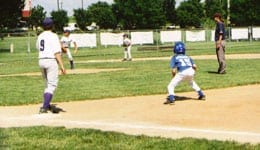Base Umpiring- A Time-Worthy Resource
Below we check out the other Blue Crew member:
The field or base umpire.
How does he set up?
Where does he go?
What does he do?
I. Ground Ball Coverage
a. Respond to the batted ball.
b. Move three-four quick steps.
c. Stop just before the ball reaches the infielder.
d. Let the throw take you to the play.
U2 Basics
1st Heads Up
First play in the infield belongs to you.
2nd Heads Up
Use P2R (Pause, read, react)
Pause: stop when ball gets to fielder.
Read: catch, no catch?
React: let the throw take you to the play. Make the safe/out call.
3rd Heads Up
It’s nothing until you call it!
Ground ball fast, fielded, quick out.
Long throw from deep, close play, you have to “sell it”.
Take your time on the call.
Make the call clear, concise.
Out, throw the hammer.
Safe, make an “x” in front of you.
Diamond layout: U2 has three places he works from: the A position, the B position, the C position.
The A Position
With no runners, keep an eye on the pitcher, watch him deliver, watch what the batter does. Whether or not he puts the ball in play.
How Does He Set Up?
Like the plate umpire, U1, he is in HOK (Hands on Knees) position.
When the pitcher deals, he might take a step toward the plate.
Where Does He Go?
No runners on, sets up in the A position.
Approx. 10 feet behind 1B.
What Does He Do?
Ground ball to ss, 2/3’s of the time.
Runs into the infield 5-6 quick steps.
Stops uses P2R.
The B Position
With a runner at 1B, set up in the B position. You are left of the pitcher. HOK. (Situation: Less than two outs.)
The Usual, HF (High Frequency:)
HOK.
Check pitcher.
Check runner.
GB to ss.
Let the throw take you to the play.
With the Lead Runner, Play at 2B:
Take your time on the call, safe/out.
2B has his foot on the bag.
Runner must slide to avoid.
MF (Medium Frequency) Note: Depends on Overall Infield Skill Level:
Turn a double play.
HF (out at 2B) …safe/out call.
LF (out at 1B) …safe/out call.

With a runner at 2B, set up in the C position. You are to the right of the pitcher. HOK.
The Usual, HF (High Frequency:)
HOK.
Check pitcher.
Check runner.
GB to ss.
Solid skill level, ss will hold R1 at 2B.
Throw to 1B…safe/out call.
With a runner at 3B, set up in the C position. You are to the right of the pitcher. HOK.
HOK.
Check pitcher.
Check runner.
GB to ss.
Solid skill level, ss will hold R1 at 2B.
Throw to 1B…safe/out call.
Heads Up
U1 will have stayed at home plate in case runner tries to score.
II. Fly Ball Coverage
In order of frequency:
GB to ss.
Fly ball to lf.
Fly ball to cf.
In this case, you have added responsibility. Fly ball and the runner.
Use P2R—Pause, Read, React
U2 Double Duty
Pause, Read, React if FB (fly ball) is deep enough to the outfield, R1 will tag up and try to advance.
U2 has to see the catch.
Watch the tag-up.
Follow R1 to 2B.
Make safe/out call.
FYI Teams challenge advancing runner. “I saw him tagging up coach.”
FYI Teams challenge the close play at 2B on the runner trying to advance on the steel. “I saw the tag coach.”
III. Working With Your Partner
Fourth Key Heads Up
Lead runner is the focus
A. U2 is responsible for first play in the infield.
B. U1 acts as backup.
C. “I got the catch, Bill.”
D. “I’ve got home, Jerry.” (U1 might point to home plate before first pitch of new batter—this means he has play at the plate. U2 might point to 3B, he has the play at 3rd on the tag up.
Situation: GB to ss—throw gets by 1B
- U1 has overthrown ball.
- U2 has play at 2B.
- Safe/out call.
Situation: FB to lf, cf, rf (less than two outs)
E. U2 in “work area”.
- The work area is like the “batter’s box” behind the pitcher’s mound.
- This is what U2 uses as his base for coverage when runners are on base.
- Catch, no-catch.
- Runner tries advance.
- Did he tag up?
- Tell coach if challenged, “I had him tagging coach.
F. U1 coverage.
- U1 responsible for play at the plate.
- U1 usually responsible for 2nd play in the infield.
FYI U2, follow the lead runner. U1, if there’s no play at the plate, can cover secondary runner.
Tip Go over signals, coverage before the game starts, between innings.
Tip Never talk to fans. Coaches when only necessary.
Diagrams and stuff: 210. 211. 209
Working from work area
Coverage, 232, 233, 234, 235, 248